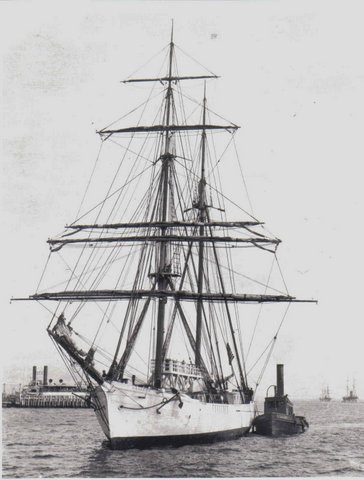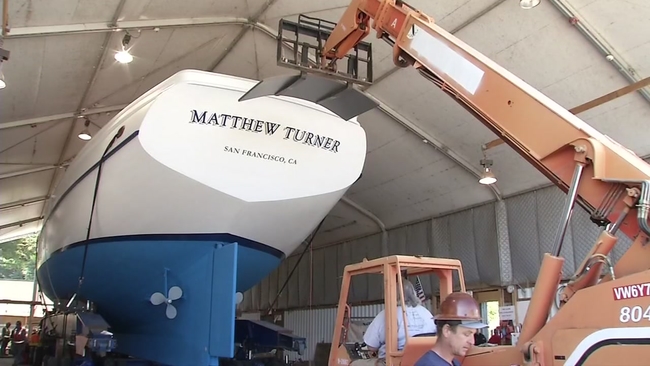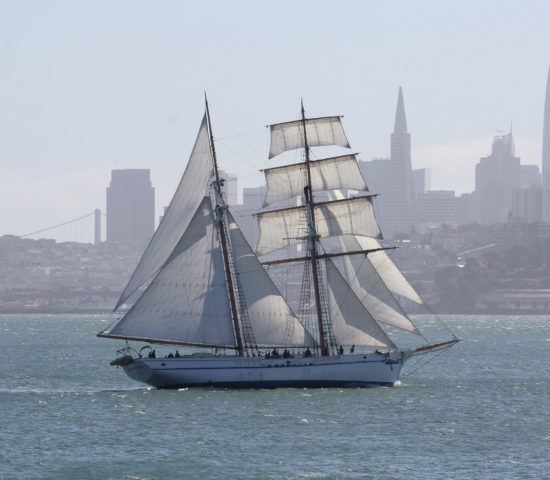
Educational Tall Ship, now Call of the Sea, set out to construct a historic and sustainable wooden tall ship, Matthew Turner, for the San Francisco Bay Area. The project will provide on the water and shore-based experiential education for students of all ages, both during construction and after completion. Programs will focus on marine ecology, sustainability, teamwork, leadership and the rich maritime history of the Bay Area.
Matthew Turner will inspire people to celebrate and experience the rich maritime history of the Bay Area, provide a platform to learn about and preserve our delicate ecosystem and offer life-changing experiential learning opportunities for youth of all backgrounds, now and for generations to come.
History Comes Alive: San Francisco’s Maritime Heritage
The inspiration for our tall ship design comes from Matthew Turner, who immigrated to the Bay Area from his home on the shores of Lake Erie in 1850. He came to California to try his luck in the gold fields and, finding success, he traveled back to the East Coast to purchase a ship, for he saw more potential in the shipping business than in the gold trade. He began his career in the booming coastal lumber trade and quickly found that he needed more ships. Not impressed with the available vessels at that time, he pulled together what he had learned from his father about ship design and building on Lake Erie, and his experience with contemporary vessels in the Pacific, to build his first ship, the Nautilus, in 1868. The Nautilus outperformed all other ships of the time, raising the bar in sailing ship design. At that time on the East Coast, design innovation in commercial sail was at a standstill, as steamships became the focus.
But on the West Coast, long distances, lack of coal and the industrial capacity to produce large steam engines gave sailing vessels the edge until the turn of the century. The Nautilus launched Turner’s career and he is considered the most prolific builder in history, with 228 vessels built by the end of his career in 1907.
His vessels were responsible for the success of many entrepreneurs of his time. Matson Lines began their operations with the Lurline. Spreckles Sugar had a fleet of Turner’s ships, as did C&H Sugar. His ships moved between San Francisco and Hawaii at record speeds, making 13 round trips in one year, including loading and unloading. Only the largest and fastest modern sailing yachts can hope to beat the 8 days and six hours trip From SF to Hawaii by the Lurline and the 9 day trip from Honolulu to SF by the W.G. Irwin. Turner himself discovered the Alaska cod industry and owned and operated the first packet ships between San Francisco and Tahiti.


Matthew Turner’s Innovation: Full Aft Narrow Fore
Matthew Turner was more than just the most prolific builder of sailing ships in history, he was also responsible for one of the greatest innovations in commercial sailing vessel hull design. By moving the displacement of the ship aft Turner was able to narrow the bow of the ship. This made for a sleeker entry through the water which gave his vessels more speed and stability. Prevailing wind and sea conditions differed greatly from the Atlantic to the Pacific. Turner’s new design favored the conditions of the Pacific and made for a better sailing ship at all points of sail. This innovation and several other Matthew Turner design features helped propel his vessels to out-perform all other sailing ships of the era.
The Galilee (pictured right) was a brigantine built in 1891 and designed by Matthew Turner. She was used as a cargo ship, traveling between San Francisco and Tahiti, and was considered very fast, once completing the journey in a record 19 days. In 1905, the Galilee was chartered by the Carnegie Institution’s Department of Terrestrial Magnetism and converted into a magnetic observatory. Galilee ended her days in Sausalito where she sat in the mudflats as a house boat. She was later dismantled and her original transom is located at Fort Mason in San Francisco.


A Modern Brigantine Inspired by Matthew Turner
Matthew Turner’s legacy is impressive and many of his vessels are worthy of reproduction, but none of his original designs could satisfy our mission to provide experiential, environmental education under sailing on an educational tall ship that represents the San Francisco Bay Area’s rich maritime history. Unlike Turner’s ships that hauled cargo, the new vessel hauls students as her passengers. To bridge the old with the new, we commissioned Tri-Coastal Marine, Inc. to design an all-new vessel based on Turner’s original plans. The new ship has many characteristics that can be found in Mr. Turner’s designs including: a relatively flat sheer, fine entry, straight run, and little drag in the keel. The sail plan mimics his traditional brigantine rig right down to the ringtail sail; however, our vessel must comply with USCG passenger carrying requirements. This places many ‘modern’ constraints on the Matthew Turner’s design that were not originally an issue a hundred years ago. For example, the sail area and hull form has to meet various stability criteria. Safety requirements dictate the use of water tight bulkheads with sliding watertight doors to allow passage between compartments without going on deck. A second regenerative power system has to be present to power the vessel when there is no wind. Turner’s clients would have been waiting for the wind to pick up again before continuing on. In addition, a ship of this size requires a twin steering design (known as a two screw) that can steer the ship in ways other than the central steering wheel.



